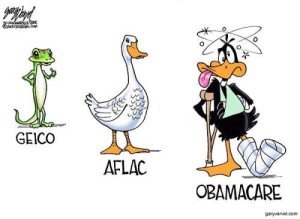 The left claims there is no viable alternative to the government take-over of health care, but alternatives to ObamaCare existed at the time of the debate and they still exist today.
The left claims there is no viable alternative to the government take-over of health care, but alternatives to ObamaCare existed at the time of the debate and they still exist today.
Senators Tom Coburn, a physician, Richard Burr, R-NC, and Orrin Hatch, R –Utah have introduced a credible alternative – The Patient Choice, Affordability, Responsibility, and Empowerment Act (CARE) based on principles that will lower costs and expand access to quality coverage and care by empowering Americans to make their own health care decisions, rather than empowering government to make those decisions for us.
The Center for Health Economy’s economic analysis that found that CARE, when compared to ObamaCare, will actually lower insurance premiums across the board, improve Medical Care Productivity by 2 to 3 percent, and reduce the national debt by decreasing federal spending by almost $1.5 trillion over the next ten years. Additionally, the CBO has determined that CARE is fully paid for, will provide coverage to more than 94% of Americans while staying under the $900 billion limit that President Obama established.
CARE includes versions of ObamaCare’s most popular provisions that end pre-existing conditions limitations, continues dependent coverage up to age 26 and keeps the $700 billion in Medicare savings. It would replace Obamacare’s premium hikes on young people, known as age-based community rating, with a more traditional 5:1 rating band. But, instead of a host of Obamacare taxes and fees, the plan defrays cost by capping the tax exclusion for employer-provided health insurance.
There are no exchanges in the Republican plan, nor is there a set of benefits that insurance plans must cover. The GOP alternative expands health care coverage by offering tax credits instead of greatly increasing Medicaid eligibility. This new plan would encourage medical malpractice reform by either adopting or incentivizing states to legislate a range of solutions to tackle the problem of junk lawsuits and defensive medicine. It would strive to expand price transparency and the supply of physicians.
The Senators included Medicaid reform using an approach first proposed by Bill Clinton, and endorsed by former Democratic Senate Majority Leader Tom Daschle – per-capita caps. Under the per-capita cap approach, the federal government would give states a fixed amount of money per person enrolled in Medicaid and it would then be up to the states to use that money in the most cost-efficient way possible. Another attractive proposal of CARE is that Medicaid enrollees could receive the money directly to buy coverage of their choice with an auto-enroll feature
Senator Burr says that this plan addresses a distortion in the tax code that dries up health care costs by capping the exclusion of an employees’ employer-provided health care at 65% of the total cost of the most generous employer plan on the market, much like current union plans. Those with employer sponsored health insurance would not see any change in the tax treatment of their benefits unlike ObamaCare’s Cadillac tax which imposes an across the board 40% excise tax on the richest plans regardless of an individual’s income. Under CARE, health benefits above the threshold would be treated as regular income for that employee which Americans for Tax Reform says will produce a net tax cut.
Targeted tax credits, adjusted for age and income, will give individuals purchasing power and the opportunity to choose a plan that meets their specific needs. Because costs are lowered through medical malpractice reform and increased transparency, these dollars will go further.
Is CARE perfect? NO! But it definitely is a starting point to provide real health care reform and stop the government destruction of our health care system.

